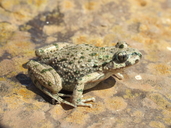|
Description
Males up to 39.5 mm, females up to 41.5 mm. Male size smaller than P. punctatus, much smaller than P. caucasicus. Head dorsally flattened, proportionally wider, with snout less prominent and shorter than in P. punctatus. Prominent eyes which have vertical pupils. Ear-drum sometimes visible. Relative length of fore and hind limbs and fingers shorter than in P. punctatus. Hind toes almost completely unwebbed. Proximal subarticular tubercles conical (rounded in P. punctatus). Dorsal skin smooth to granular, with prominent round to ovoid warts. Dark grayish olive color, with small and ovoid darker olive green spots. In some individuals there are two pale dorsal bands making an "X"-shaped design. Venter white to pale cream. Nuptial pads in breeding males brown to black. Distribution and Habitat
Country distribution from AmphibiaWeb's database: Portugal, Spain
Endemic from the Iberian Peninsula, occurs at central and south Portugal, and the Spanish Andalusian (Cádiz, Málaga, Jaén, Cordoba, Sevilla and Huelva) and Badajoz provinces. Its altitudinal distribution ranges from lowlands, including areas close to the sea, to the medium altitude (900 m) mountain regions of Sierra Morena. It prefers open areas with high insulation.Life History, Abundance, Activity, and Special Behaviors
In the southeast it is active year-round, showing the maximum activity from November to January, and poor activity during the summer. Breeding takes place from October to April. It breeds in ponds shallow to medium in depth, seasonal streams and flooded areas. Clutches contain 105-335 eggs. Egg size varies from 1 to 1.5 mm, and they have a 2-3 mm thick gelatinous string. Incubation lasts just 6-9 days. The larvae are about 4 mm long at hatching, and they develop in 2.5 months, when they reach 10-21 mm. Locally abundant in the lowlands of Huelva and Cádiz, their populations are dispersed in the rest of their distribution. In general, the species is not scarce, but deep studies in the whole range of distribution are needed. Trends and Threats
No special threats can be found for this species, just the common problems of habitat destruction and pollution (specially related to agricultural practices). Populations in the southeast distribution specially affected by the lost of traditional uses of lands, which provided water bodies used for reproduction. Relation to Humans
No special relation, just the use of artificial ponds related to agricultural and cattle practices in the wet areas where the species occurs. Possible reasons for amphibian decline General habitat alteration and loss
Comments
Recently described species, most populations of its northeast distribution have no species status assigned yet.
References
Barbadillo, L. J. (2002). ''Pelodytes ibericus (Sánchez-Herráiz, Barbadillo, Machordom y Sanchíz, 2000). Sapillo moteado ibérico.'' Atlas y Libro Rojo de los Anfibios y Reptiles de España J. M. Pleguezuelos, R. Márquez, and M. Lizana, eds., Dirección General de Conservación de la Naturaleza-Asociación Herpetológica Española, Madrid.
Barbadillo, L. J., Lacomba, J. I., Pérez-Mellado, V., Sancho, V., and López-Jurado, L. F. (1999). Anfibios y Reptiles de la Península Ibérica, Baleares y Canarias. Geoplaneta, Barcelona.
Paillette, M., Oliveira, M. E., Rosa, H. D., and Crespo, E. G. (1992). ''Is there a dialect in Pelodytes punctatus from southern Portugal?'' Amphibia-Reptilia, 13, 97-108.
Salvador, A. and García-París, M. (2001). Anfibios Españoles. Identificación, Historia Natural y Distribución. Canseco Editores, Madrid.
Sánchez-Herráiz, M. J., Barbadillo, L. J., Machordom, A., and Sanchiz, B. (2000). ''A new species of pelodytid frog from the Iberian Peninsula.'' Herpetologica, 56, 105-118.
Originally submitted by: Jaime Bosch (first posted 2004-01-27)
Edited by: Tate Tunstall (2004-02-27)Species Account Citation: AmphibiaWeb 2004 Pelodytes ibericus: Iberian parsley frog <https://amphibiaweb.org/species/5902> University of California, Berkeley, CA, USA. Accessed Jun 2, 2025.
Feedback or comments about this page.
Citation: AmphibiaWeb. 2025. <https://amphibiaweb.org> University of California, Berkeley, CA, USA. Accessed 2 Jun 2025.
AmphibiaWeb's policy on data use.
|



 Map of Life
Map of Life